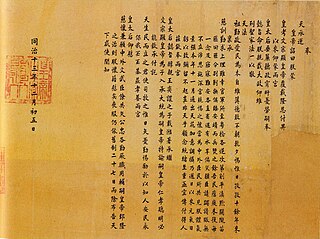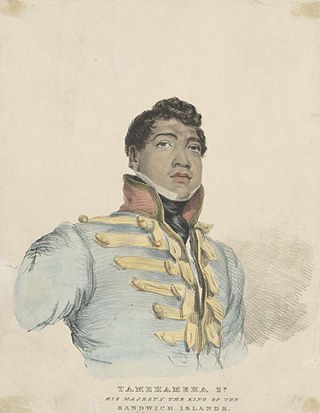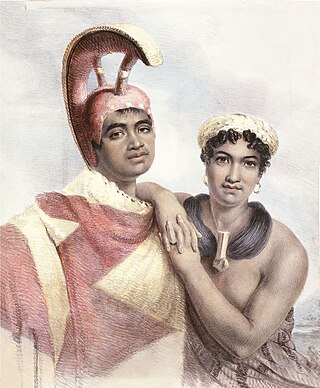
An edict is a decree or announcement of a law, often associated with monarchism, but it can be under any official authority. Synonyms include "dictum" and "pronouncement". Edict derives from the Latin edictum.

An edict of toleration is a declaration, made by a government or ruler, and states that members of a given religion will not suffer religious persecution for engaging in their traditions' practices. Edicts may imply tacit acceptance of a state religion.

Kamehameha II was the second king of the Kingdom of Hawaii from 1819 to 1824. His birth name was Liholiho and full name was Kalaninui kua Liholiho i ke kapu ʻIolani. It was lengthened to Kalani Kaleiʻaimoku o Kaiwikapu o Laʻamea i Kauikawekiu Ahilapalapa Kealiʻi Kauinamoku o Kahekili Kalaninui i Mamao ʻIolani i Ka Liholiho when he took the throne.

Lunalilo was the sixth monarch of the Kingdom of Hawaii from his election on January 8, 1873, until his death a year later.

The Cathedral Basilica of Our Lady of Peace is the mother church and cathedral of the Diocese of Honolulu.

Kamehameha IV, reigned as the fourth monarch of Hawaii under the title Ke Aliʻi o ko Hawaiʻi Pae ʻAina of the Kingdom of Hawaii from January 11, 1855, to November 30, 1863.

Kawaiahaʻo Church is a historic Congregational church located in Downtown Honolulu on the Hawaiian Island of Oʻahu. The church, along with the Mission Houses, comprise the Hawaiian Mission Houses Historic Site, which was designated a U.S. National Historic Landmark (NHL) in 1962. In 1966 it and all other NHLs were included in the first issuance of the National Register of Historic Places.

Kamehameha III was the third king of the Kingdom of Hawaii from 1825 to 1854. His full Hawaiian name was Keaweaweʻula Kīwalaʻō Kauikeaouli Kaleiopapa and then lengthened to Keaweaweʻula Kīwalaʻō Kauikeaouli Kaleiopapa Kalani Waiakua Kalanikau Iokikilo Kīwalaʻō i ke kapu Kamehameha when he ascended the throne.

The Church of Hawaiʻi, originally called the Hawaiian Reformed Catholic Church, was the state church and national church of the Kingdom of Hawaiʻi from 1862 to 1893. It was the ecclesiastical province of the Anglican Communion in Hawaiʻi, which later merged into the American Episcopal Church during the establishment of the Republic of Hawaii.

The Roman Catholic Diocese of Honolulu is a Latin Church ecclesiastical territory or diocese for the state of Hawaii in the United States. It is a suffragan diocese in the ecclesiastical province of the metropolitan Archdiocese of San Francisco.

Kuini Liliha was a High Chiefess (aliʻi) and noblewoman who served the Kingdom of Hawaii as royal governor of Oʻahu island. She administered the island from 1829 to 1831 following the death of her husband Boki.

Alexis Bachelot, SS.CC., was a Catholic priest best known for his tenure as the first Prefect Apostolic of the Sandwich Islands. In that role, he led the first permanent Catholic mission to the Kingdom of Hawaii. Bachelot was raised in France, where he attended the Irish College in Paris, and was ordained a priest in 1820. He led the first Catholic mission to Hawaii, arriving in 1827. Although he had expected the approval of then Hawaiian King Kamehameha II, he learned upon arrival that Kamehameha II had died and a new government that was hostile towards Catholic missionaries had been installed. Bachelot, however, was able to convert a small group of Hawaiians and quietly minister to them for four years before being deported in 1831 on the orders of Kaʻahumanu, the Kuhina Nui of Hawaii.
Columba Murphy, SS.CC. was French Catholic priest of the Congregation of the Sacred Hearts of Jesus and Mary, a religious institute of the Roman Catholic Church. He helped found the Roman Catholic mission in the Gambier Islands and was one of the first Catholic missionaries to arrive in the Kingdom of Hawaii during the persecution by Kaʻahumanu, Kamehameha III and their American Congregationalist advisors.

Saint Michael the Archangel Catholic Church is a parish of the Roman Catholic Church of Hawaiʻi in the United States. Located in Kailua-Kona on the Big Island of Hawaiʻi, 75-5769 Ali'i Drive, coordinates 19°38′13″N155°59′28″W. The church falls under the jurisdiction of the Diocese of Honolulu and its bishop. On June 17, 1839, Kamehameha III declared religious freedom in the Kingdom in the Edict of Toleration. A mission named after Saint Michael the Archangel was founded in 1840, the first Catholic Church on the island. The first services were in a small grass hut. Governor John Adams Kuakini gave the land South of Mokuʻaikaua Church to the Catholic mission in 1841. The present church was completed in 1850 under Father Joachim Merechel. He was buried inside the church in 1859. In 1940 Father Benno Evers constructed a grotto of coral from Kailua Bay over the site of the original well.

Boki was a High Chief in the ancient Hawaiian tradition and served the Kingdom of Hawaii as royal governor of the island of Oahu. Boki ran a mercantile and shipping business and encouraged the Hawaiians to gather sandalwood for trade.

The Hawaiian Kingdom, also known as Kingdom of Hawaiʻi, was a sovereign state located in the Hawaiian Islands which existed from 1795 to 1893. It was established during the late 18th century when Hawaiian chief Kamehameha I, from the island of Hawaii, conquered the islands of Oahu, Maui, Molokai, and Lanai, and unified them under one government. In 1810, the Hawaiian Islands were fully unified when the islands of Kauai and Niihau voluntarily joined the Hawaiian Kingdom. Two major dynastic families ruled the kingdom, the House of Kamehameha and the House of Kalākaua.

The Laplace affair or the French Incident was a military intervention by the Kingdom of France in 1839 to end the persecution of Catholics in the Kingdom of Hawaii, which had been promoted by Protestant ministers. Under the threat of war, King Kamehameha III agreed to the French demands to stop the detention of Catholic citizens and pay reparations.

Hawaii–Tahiti relations refers to the historical relationship between the independent Hawaiian Kingdom and the Kingdom of Tahiti. Relations included one treaty, proposed marriage alliances and exchanges of trade and diplomatic representatives from the early 1800s to 1880.
George Luther Kapeau was a noble and statesman in the Kingdom of Hawaii who was one of the first generation of native Hawaiians to receive a Western education at the missionary founded Lahainaluna School. Despite his obscure family status, he rose to prominence as an advisor to King Kamehameha III. He served many government posts such Royal Governor of the Island of Hawaiʻi and member of the House of Nobles.

Hawaiian Independence Day was a national holiday celebrated annually on November 28 to commemorate the signing of Anglo-Franco Proclamation of 1843, the official diplomatic recognition of the independence and sovereignty of the Hawaiian Kingdom by Great Britain and France. It is still celebrated today by proponents of the Hawaiian sovereignty movement.

















